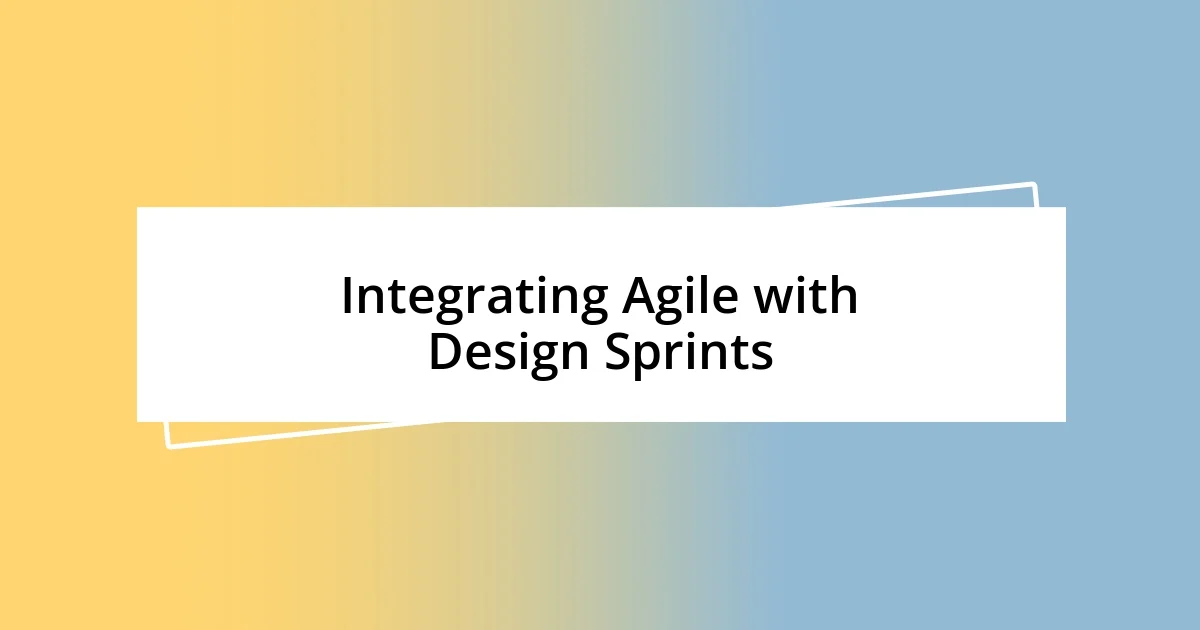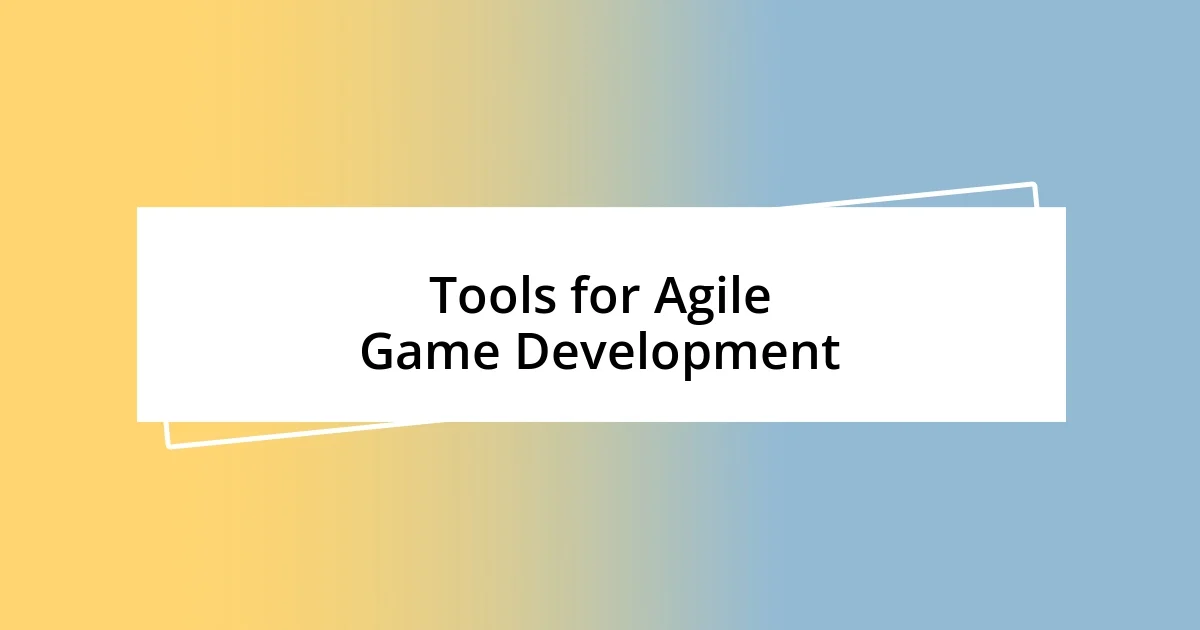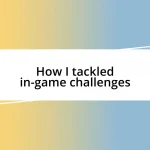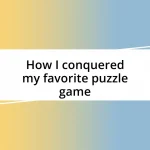Key takeaways:
- Switching from the traditional waterfall method to Agile allowed the team to adapt quickly to player feedback, enhancing player experience and creativity.
- Integrating Agile with design sprints fosters a collaborative atmosphere, enabling rapid adjustments and experimentation that can lead to unexpected breakthroughs.
- Establishing clear communication, embracing failure, and setting achievable goals within sprints are crucial for successful Agile implementation in game design.

Understanding Agile in Game Design
Agile in game design is all about flexibility and iterative development. I remember a project where our team was stuck in the traditional waterfall method—everything felt so rigid. When we finally switched to Agile, it was like a breath of fresh air; we could adapt and respond to player feedback faster, and the game evolved in ways we hadn’t initially imagined.
One defining aspect of Agile is the focus on collaboration and continuous improvement. During sprint reviews, I often saw team members eagerly sharing ideas and suggestions. It’s incredible how a simple daily stand-up meeting can spark creativity and motivate everyone to contribute their unique skills, making the collective vision that much stronger.
Embracing Agile also means welcoming change—even late in development. I vividly recall a time when a fundamental game mechanic was reworked just a few weeks before launch. Initially, I felt nervous about the decision, but the team’s excitement about the new direction was infectious. Have you ever found that a risky change made all the difference in a project? In this case, it did, leading to a richer and more engaging player experience.

Benefits of Agile Methodology
Adopting Agile methodology in game design has transformed how I approach projects. One of the significant benefits I’ve experienced is the enhanced ability to respond to changing requirements or unexpected challenges. I recall a project where we were developing a hugely ambitious open-world game, and after several iterations, player feedback led us to change several core elements. This flexibility not only improved our game but also kept morale high as everyone felt involved in the decision-making process.
Here are a few key benefits of Agile methodology that stand out to me:
- Faster Iterations: Short development cycles (sprints) allow for quick testing and feedback.
- Player-Centric Development: Incorporating player feedback ensures the game resonates with its audience.
- Collaboration: Frequent team interactions boost creativity and bring diverse perspectives into the mix.
- Risk Management: Early detection of issues means we can pivot easily to avoid major pitfalls.
- Continuous Improvement: The focus on feedback loops drives ongoing enhancement, refining both the game and the team’s skills.
In my experience, engaging with Agile has led to positive surprises. Sometimes, the best ideas emerge from a spontaneous team brainstorm during the daily stand-up. These moments of collaboration remind me how vital every viewpoint is in creating something truly memorable.

Integrating Agile with Design Sprints
Integrating Agile with design sprints has been a game-changer in my experience. I recall a particularly intense design sprint where our team collaborated to prototype a new game feature. The energy was electric, and the quick feedback loops helped us refine our ideas almost in real time. It struck me how this iterative process not only accelerated development but also aligned everyone’s vision, ensuring that we were all on the same path.
One aspect I appreciate about combining Agile with design sprints is the ability to make rapid adjustments based on insights gained during the sprint. For instance, after testing a new mechanic, we realized it was not resonating as we intended. Instead of dwelling on it, we swiftly pivoted, brainstorming alternative solutions during our retrospective. The collaborative atmosphere during these sessions is invigorating; you can feel the creativity flowing as we tackle problems together, driving our designs toward better outcomes.
As I’ve seen firsthand, integrating Agile principles within design sprints cultivates a culture of experimentation and learning. I remember a sprint where we attempted an ambitious mini-game as a side project. Initially, we were skeptical about it, thinking it wouldn’t fit into our main game. However, towards the end of the sprint, we discovered that this quick prototype could add multiple layers of gameplay. It reminded me that fostering a playful spirit can lead to unexpected breakthroughs.
| Aspect | Agile | Design Sprints |
|---|---|---|
| Focus | Iterative development and feedback | Rapid prototyping and testing |
| Duration | Continuous, ongoing process | Time-boxed, typically 1-2 weeks |
| Collaboration | Cross-functional team interactions | Intense teamwork and brainstorming |
| Flexibility | Adapts as needs change | Rapid iterations allow for quick adjustments |

Tools for Agile Game Development
When it comes to tools that enhance Agile game development, I’ve found that project management software like Jira can be an absolute game-changer. It allows me to set up user stories, track progress through sprints, and facilitate clear communication among team members. I remember feeling a sense of relief the first time I used it—seeing our tasks laid out helped the whole team visualize our goals and stay focused. How many times have I navigated chaotic project updates? Too many to count, but tools like this bring structure and clarity.
Then there are collaboration platforms like Miro or FigJam, which I cherish for brainstorming sessions. These tools create an environment where everyone can plug in their ideas visually, regardless of their location. During one memorable remote brainstorming session, our team used Miro to flesh out concepts for a character’s backstory. We were placing sticky notes, drawing connections, and suddenly, the backstory transformed into something far richer than I had imagined. Have you ever felt that rush when ideas flow so freely? It’s electrifying.
Lastly, I can’t emphasize enough the importance of prototyping tools like Unity or Unreal Engine in the Agile process. Rapidly building and testing game mechanics allows me to see what works and what doesn’t firsthand. I’ll never forget the thrill of piecing together a prototype in Unity for a multiplayer feature; the excitement of watching how players interacted was surreal. The immediate feedback shaped our approach significantly. Isn’t it fascinating how a simple prototype can ignite a whirlwind of creativity and direction?

Tips for Successful Agile Implementation
When implementing Agile in game design, I’ve learned that establishing clear communication channels is crucial. During one of my projects, we hit a snag because team members were working in silos, and valuable insights were getting lost. I initiated daily stand-up meetings, and I can’t stress how much that simple shift transformed our collaboration. Have you ever noticed how just a few minutes of sharing updates can unlock new perspectives? It’s like opening a window to fresh air; everything became more transparent and energized.
Another tip I heavily rely on is embracing failure as part of the process. Early on in my Agile journey, I was hesitant to experiment too freely, fearing negative outcomes. I vividly recall a sprint where we tried a radical mechanic that ultimately didn’t pan out. But instead of wallowing in disappointment, we analyzed what went wrong and extracted insights that informed future iterations. It taught me that every setback can be a stepping stone. How often do we let fear of failure hold back our creativity? The freedom to fail and learn transformed our team’s dynamic and led to some of our strongest ideas.
Setting achievable goals within each sprint is another key element I’ve found effective. I remember a time when we overloaded our sprint with ambitious tasks, thinking we could do it all. The result? A flurry of stress and a distinctly unproductive week. Now, I focus on prioritizing a few critical features that can be realistically completed. This way, we celebrate small victories, which boosts morale and motivation. Doesn’t it feel rewarding to tick off a task and see tangible progress? Keeping the scope manageable has been a game-changer in how we approach our development cycles.














